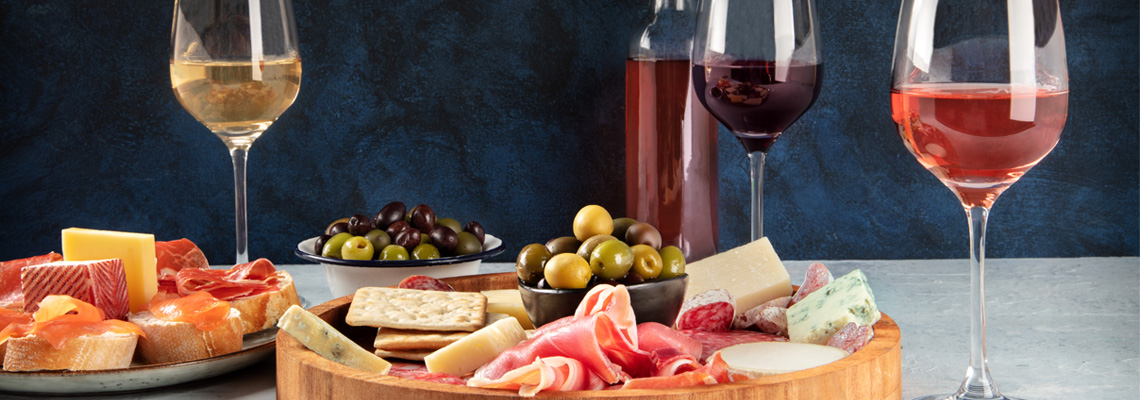
Elevate your culinary experiences by creating a harmonious symphony of textures and flavours with different pairings. Cheeses from France can be paired with various wines and other food to create a unique culinary experience. Most pairings are built around variances and similarities of flavours. For instance, the flavours and textures may mirror or match each other. Contrasting flavours usually balance each other out, so you can relish in the subtle sweetness of the cheese board with a little toasty note and crunch. When selecting complementary flavours and textures, pay attention to the taste to create a memorable sensory journey. Discover how to pair your cheeses from a French and American cheese shop with wine and other foods.
Wine and Pairing Considerations
Wines offer distinct characteristics from their rich history, influencing their pairing potential. For instance, red wines have bold and complex flavours ranging from dark fruity taste to earthy notes. White wines have a crispier and light profile, mainly from citrus, floral and tropical fruit flavours. Sparkling wines usually bring effervescence and celebratory vibes, with flavours ranging from dry and crisp to fruity and sweet. On the other hand, rose wines strike a balance between white and red, giving you fruity and refreshing notes. When pairing wine with your cheese board, factors like tannings, acidity and sweetness play a crucial role. The acidity in wine should cut through the richness of your cheeses or complement it for a harmonious balance. For instance, the sweetness in wine can contrast the saltiness in some cheeses or enhance the creaminess of others. Red wines usually have more tannings that interact with the fat in your cheeses, allowing the flavours to mingle.
Explore Varieties and Flavours for Better Pairings of Cheeses
Cheeses from France are timeless indulgences and are available in diverse varieties that influence the pairing options. Soft cheeses like Camembert have delicate and creamy textures with buttery and earthy notes. Semi-soft cheeses have a range of flavours, from mild to tangy and nutty. Soft cheeses usually provide a luscious and creamy mouth feel with a symphony of flavours. Hard cheeses like Parmesan and Cheddar have a firm and crumbly texture with robust flavours and sharpness. The dense texture provides a unique experience. Fresh cheeses like mozzarella and ricotta have a mild taste and are moist. That's why they are used as accompaniments in various dishes. Blue-veined cheeses like Gorgonzola usually give an intense and tangy flavour with distinctive blue mould veins. With any dish, cheeses tantalise the taste buds with their unique textures, flavours and aromas. The creamy to dense textures pair with a variety of wines and foods. Flavours also range from subtle to assertive to bold while the aromas vary, and you can choose from sweet and savoury to nutty, creating unique sensations with different pairings.
How to Create a Harmonious Blend of Wine and Pairings of Cheeses
When choosing the perfect wine to match your cheese, consider the gourmet products' flavours and the wine's characteristics. You can create complementary combinations with the following tips in mind:
Match Intensity
Wines and cheeses with similar intensities always match in flavours. Hence, delicate cheeses with subtle flavours work well with lighter wines, while bold cheeses go well with rich wine varieties. If you have semi-soft and nutty cheeses like Fontina and Gruyere, go for medium-bodied wines to avoid overwhelming the flavours. Aged cheddar is sturdy and can stand up to rich, full-bodied wines.
Complement or Contrast Flavours
You can complement or contrast the flavours for a harmonious blend. For instance, soft cheeses are creamy and buttery; you can balance the creaminess with an acidic or crisp white wine. A cheese board with a robust and earthy combination requires contrasting pairings like fruity red wine. Other opposite pairings include pairing rich and savoury cheeses with dessert wines for an intriguing combination.
Pay Attention to the Texture
The texture of the gourmet products and wines should factor into the pairings. As a thumb rule, rich and velvety wines pair well with creamy and soft cheeses from France, while the hard textures match with structured wines with tannins. Aside from the texture, balance sweet wines that complement salty and savoury cheeses. For instance, blue cheeses with salty and tangy tastes are balanced out by sweet dessert wines.
Regional Pairings
Many traditional pairings have developed over time in specific regions and offer unique flavour combinations. Check out the regional pairings for cheeses and wines and try a few varieties. For instance, Champagne from France can create a harmonious blend with tangy and creamy cheeses like Camembert.
Conclusion
Irrespective of the gourmet products you want to pair with your food or wine, ensure harmonious flavour combinations. Feel free to experiment and discover new combinations based on your taste preferences. For instance, if you love fudge brownies, you can pair them with blue cheese to combine the mild and intricate salt and sweet flavours to contrast and balance each other out.